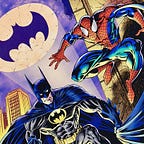The Selected Batman Re-Read, Part Six — All Around Gotham
Outside of the batcave, there are some other places in Batman’s neighbourhood worth shining a light on. And, frankly, you simply can’t do a Batman re-read that passes through the early two thousands without mentioning Gotham Central.
Ed Brubaker, Greg Rucka, Michael Lark and friends’ series that focuses on the cops in the Dark Knight’s city isn’t just one of the best Batman comics ever. It’s, hands down, the best.
It’s arguably both Brubaker and Rucka’s best work-for-hire comic too, filled with so many choice moments—from the quiet to the quite badass—but those final few pages of book four, with Montoya confronting Corrigan, and then quitting? Good goddamn. I’d been dreading getting to that ending since I started re-reading the series, but I swear, I was actually more emotional this time round. I can’t think of a single comic from either Marvel or DC that delivers a gut-punch that powerful.
And just as much credit should go to Lark and his fellow artists’ work here. A lot of the emotion comes from their brilliantly understated use of facial expressions, gestures and postures. The aforementioned scene with Montoya and Corrigan wouldn’t have had the impact it did with a lesser artist than Kano and Stefano Gaudiano. All this on top of the fact that the artists are absolutely integral to not just setting the pitch perfect pacing of the stories, but that unmistakeable mood of the city too.
Gotham Central is exciting and engaging, genuine and human—and, really, just so damn good.
Once you’ve come down from that particular emotional rollercoaster though, Rucka and JH Williams III’s Batwoman: Elegy is a fantastic follow-up. While Rucka’s on form as always, Williams and colourist Dave Stewart are undoubtedly the stars of this book.
Williams’ wonderfully unique panel layouts are just a joy to behold, but never at the cost of clear storytelling. However, it’s how well he works with Stewart—switching between a flatter, more traditional look for grounded scenes and a more ethereal feel for the scenes with The Religion of Crime—that truly elevates this book to different level of artistry. It’s stand-out stuff by Stewart, probably matched only by his work on Hellboy: The Midnight Circus.
Still, it’d be a crime not to call out the fantastic character moment by Rucka, where Kate Kane refuses to abide by “don’t ask, don’t tell” and comes out as gay. It’s such an incredibly powerful scene—and it’s crafted with the kind of care and integrity that people have come to expect from Rucka.
It doesn’t matter that the Dark Knight himself probably appears in a total of five pages across all of Gotham Central and Batwoman: Elegy—these are unquestionably essential books to read if you want the very best Batman stories.
